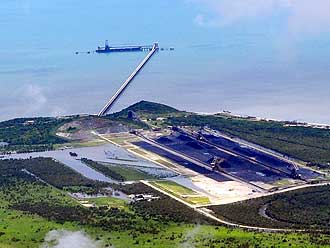Queensland government-owned utility CS Energy has thrown its weight behind plans to develop a green hydrogen and ammonia production and export facility in North Queensland, in a bid to fast-track the project dubbed HyNQ.
HyNQ, or North Queensland Energy Project, has been in the works since 2020, led by Australian renewable hydrogen hopeful Energy Estate with the ultimate goal of developing a global-scale green ammonia facility.
The company says it has now signed a consortium of “globally recognised partners” to take the project to its next stage.
The consortium includes Idemitsu Australia, a subsidiary of Japan oil giant Idemitsu Kosan, and – perhaps most significantly for this particular project – CS Energy, a state-owned electricity generator that is making the shift from coal to renewables.
Energy Estate says its new project partners will help to progress a study on the feasibility of generating and exporting green ammonia from the Port of Abbot Point near Bowen – traditionally a coal export port.
The company says one of the key goals of the project is to harness existing infrastructure and to draw on the existing experienced energy export workforce and supply chain of North Queensland.
“Bringing together a group of highly respected energy companies, each focused both on the domestic opportunities for Queensland and key export markets of Japan and Korea will help accelerate the potential of HyNQ, a project leaning-in to the opportunity for the export of ‘sunshine gas’,” says Energy Estate co-founder Vincent Dwyer.
The first job of the consortium will be to fund the ongoing pre-FEED (front end engineering design) activities, Dwyer says, and if those results are successful, to start scoping out technical issues and estimating rough investment costs.
Idemitsu Australia chief Steve Kovac says the feasibility studies are a critical step to deliver a pathway for green hydrogen and ammonia production in the state.
“This is another major opportunity for North Queensland as we continue to build low-carbon and decarbonisation businesses and pave the way for Australia’s energy transition,” Kovac says.
For Queensland Labor, having a hand in the project via CS Energy builds on the government’s own green hydrogen ambitions, and its rapidly evolving energy transition plans, which were comprehensively updated in September with its Energy and Jobs Plan.
“This is another vote of confidence from our trading partners following the release of our first-of-its-kind in Australia report highlighting Queensland’s capacity to produce and export renewable hydrogen,” said state energy minister Mick de Brenni on Wednesday.
“From our hydrogen superhighway and hydrogen training facilities to electrolyser manufacturing and export capabilities, we’re setting Queensland’s economy up to power the world’s future.”
Last year, the Queensland government owned Stanwell Corporation – also traditionally focused on coal power generation – revealed it was leading a consortium of Australian and Japanese companies to investigate the feasibility of a renewable hydrogen export facility in Gladstone.
On that project, Stanwell is partnering with the Japanese Iwatani Corporation, which will examine the feasibility of establishing a facility to produce up to 36,500 tonnes of renewable hydrogen a year and begin exporting as early as 2026.
Also in Gladstone, plans got underway in April of this year on a green hydrogen hub with the capacity for 3GW of electrolysis and the production of up to 5,000 tonnes a day of green ammonia, powered by new-build solar and wind resources.
That project is being developed by Australia-based multinational Orica and H2U Group, who are working on a first stage of the multi-billion industrial-scale H2-Hub, underpinned by a MoU to explore a green ammonia offtake and supply deal.
More recently – just a couple of weeks ago – the Palaszczuk government announced plans to develop the North Queensland Super Hub, led by Andrew Forrest’s Fortescue Future Industries and his recently acquired renewables developer Windlab.
The government said at the time that detailed planning was already underway for the Super Hub, with the first stage to include Windlab’s proposed 800MW Prairie Wind Farm and a 1GW “Wongalee project,” the details of which were not specified.
“For the first time, the North Queensland Super Hub will provide the quantity of green energy we need to support large-scale green hydrogen production right here in Queensland,” said FFI CEO Mark Hutchinson of the project.
For Energy Estate, HyNQs is just one of the company’s proposed green hydrogen projects in Australia, including its plans to develop a 1.6GW renewable hydrogen production, transportation and export hub in the New South Wales Hunter region.
In May, the company revealed plans to develop a “world first” super-hybrid green hydrogen project valued at up to $5.5 billion and combining massive wind and pumped hydro facilities and hydrogen technologies in central Queensland.
The Flavian super hybrid project, on which Energy Estate is partnering with Sunshine Hydro, proposes up to 1.8GW of new wind generation and 600MW of pumped hydro, 300MW of hydrogen electrolysers, 50MW of liquefaction, and a 50MW hydrogen fuel cell.
In offshore wind, Energy Estate is partnering with Spanish firm BlueFloat Energy on plans to develop of at least 4,300MW of offshore wind capacity in Australian waters, including a 1.4GW floating wind farm off the coast of the Hunter region and a 1.6GW project off the coast of Wollongong.
Getting shovels into the ground on all of these ambitious plans will be the big test. On HyNQ, Energy Estate says it hopes to complete pre-FEED activities in the second half of 2023 and, if all goes well, get to a final
investment decision in late 2024, early 2025, with hydrogen and ammonia production in 2027/2028.










